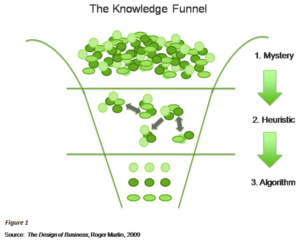 Listen closely and you realize there is a lively debate between those who believe process is most important in innovation and others who contend that vision and creativity are what leads to success. The truth is that both are equally important and organizations interested in improving their ability to innovate must do both well.
Listen closely and you realize there is a lively debate between those who believe process is most important in innovation and others who contend that vision and creativity are what leads to success. The truth is that both are equally important and organizations interested in improving their ability to innovate must do both well.
One side of the argument is rooted in the traditional management model that emphasizes efficiency. All processes, therefore, can be optimized including innovation processes. So, there is “lean” product development, applying six sigma to innovation (1), and phase-gate development processes.
Others point out that true innovation is often the result of unanticipated, accidental discovery and cannot be planned. In other words, serendipity plays a fundamental role. From this perspective, planning is a waste of time and slows the process. That what is most important is inspiration, highly engaged employees, strong visionary leadership and a culture that emphasizes creativity and risk taking. Certainly, Apple epitomizes this kind of culture.
In reality, if you dig deeper, successful serial innovators like Apple and others do both very, very well.
 The “knowledge funnel” shown in Figure 1 illustrates this point in a slightly different fashion (2). Every startup begins at the top of the funnel, wrestling with some type of mystery and generating new knowledge. Maybe it’s a new technology or perhaps a new business model. The focus is the first product and revenue.
The “knowledge funnel” shown in Figure 1 illustrates this point in a slightly different fashion (2). Every startup begins at the top of the funnel, wrestling with some type of mystery and generating new knowledge. Maybe it’s a new technology or perhaps a new business model. The focus is the first product and revenue.
Every successful business progresses to the bottom of the funnel, where new knowledge has been codified into an “algorithm”. For a manufacturing company, that algorithm can be thought of as the drawings and work procedures necessary to manufacture the product. It is only at this point where the knowledge created can be monetized.
Almost by default what is most important at the top of the knowledge funnel is creativity, vision and serendipity. Process dominates at the bottom. The challenge for a startup is that they must at some point establish processes, or they will fail to become a sustainable business. An established business must resist relying only on existing knowledge and the pursuit of maximum innovation process efficiency. You can “lean” yourself right out of business.
In my opinion, the challenge for existing organization’s to resist the urge to overly emphasize process at the expense of vision and serendipity tends to be more difficult, compared to the opposite need for the startup to implement innovation processes. Larger, established companies are more impacted by organization inertia and become very comfortable with their existing knowledge. That translates to a reliance on incrementally improving their established products. These projects are safe bets, especially for CEO’s in today’s public companies who are rewarded on quarterly numbers.
For an existing business, there are three key factors in managing for serendipity.
First and foremost, the company’s “culture” must support this notion of the ambidextrous organization. An organization that can simultaneously emphasize the need for process efficiency and the role serendipity plays in innovation success. It translates to the need to focus on innovation effectiveness, not efficiency. It means spending resources on creating new knowledge as well as extracting value from existing knowledge.
The “culture” of an organization is amorphous. It is difficult to define precisely, but speaks to “this is how we do things here and what is expected of me”. The culture has to be modeled by an engaged senior leader. From a practical standpoint, it is important that what the leader says and what they actually do are in sync. Other aspects include open and honest communication throughout the company and how “failure” is treated. This last point is important, as creating new knowledge entails risk. There will be failure. Ultimately from that failure will rise new opportunities and learning.
is how we do things here and what is expected of me”. The culture has to be modeled by an engaged senior leader. From a practical standpoint, it is important that what the leader says and what they actually do are in sync. Other aspects include open and honest communication throughout the company and how “failure” is treated. This last point is important, as creating new knowledge entails risk. There will be failure. Ultimately from that failure will rise new opportunities and learning.
Second is ensuring that the physical space is conducive to serendipity. The open-office concept is meant to support employee interaction to help create the conditions for accidental creation of new knowledge. Designing this kind of environment might not be more expensive than the alternative from a capital perspective, but takes much more foresight to implement effectively.
Finally, you must open your mind to what is happening outside your “four walls”. Many organizations become very closed-minded. They believe they have all the answers internally, and if teams just worked harder the company would be more successful at innovation. An important aspect of serendipity is to reach out beyond your company, both for ideas on products and innovation processes (3).
In summary, it is important to realize that both process and vision are equally influential in innovation success. You must do both well. For existing businesses especially, the pressure to rely on existing knowledge is immense. It is up to engaged senior management to counteract these forces by promoting a culture that supports an ambidextrous organization, providing the physical space that encourages serendipity and looking outside the confines of your business for inspiration.
Notes:
- For an interesting example of how applying six sigma to the 3M innovation process nearly destroyed the innovative culture, see this article: Peppers, Don. May 5, 2016. The Downside of Six Sigma. LinkedIn
- For more on the knowledge funnel, see: Roger Martin, The Design of Business. (Boston, MA: Harvard Business Press, 2009)
- For example: Innovate to Accelerate Business Growth Workshop, and Your Innovation Coach online coaching.
 Bio
Bio
Jeff Groh is President of New Product Visions located in Flat Rock, NC. New Product Visions helps companies drive revenue and earnings growth by improving their innovation management practices. We focus on processes, organization, management engagement and culture. Services include consulting, Innovation Coach™ Workshops, Your Innovation Coach online consulting service and software enablers. Mr. Groh spent 30+ years in industry in a variety of management roles in sales, manufacturing and new product development prior to starting New Product Visions. For additional information or to join our mailing list, contact us. Available for select speaking engagements.


Be the first to comment on "Process or Vision: What’s More Important for Product Innovation Success?"